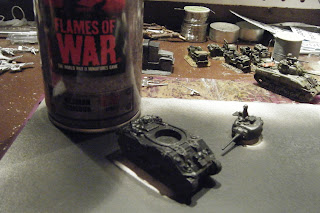After adding all the extra stowage, tow cable, etc. I washed the model in warm water with a few drops of dishwashing soap in it to remove any residue from manufacturing. Once dry, I spray primed the tank with Battlefront's German Armour. I use this on most of my FoW stuff.
In the order of application, here are the paints used. Unless specified otherwise, all of the paint colors are Vallejo:
1. Brown Violet - Heavy drybrush over most of the tank
2. German Grey - Heavy drybrush on tracks and contact surfaces of roadwheels, also for MG's
3. Calthan Brown (Citadel) - wooden tool handles, crates, etc.
4. US Field Drab/Khaki/Tan Earth/Green Grey/Brown Violet - any combination or mixture of these colors to represent the varying shades of US field gear on bedrolls, packs, etc.
5. Gunmetal (Citadel) - exposed metal such as metal parts of tracks, tow cables, fairly fresh battle damage, MG's. I will often mix German Grey to tone down the "metallic" shimmer
6. Red Leather (Vallejo)/Scorched Brown (Citadel) - very light to moderate drybrushing to represent rust
7. Graveyard Earth (Citadel) - very light to light drybrush for weathering
8. Ryn Flesh (Formula P3) - Flesh base coat
Those are the main paints and their applications that I use. Not included are the colors for crew uniforms or very small detail items (i.e. Taillights).
Once the basecoating is done (before weathering), I apply Gloss Varnish (Vallejo) to the areas where I am going to place decals. The order of the process, allowing drying time between each step, is:
1. Gloss Varnish
2. Apply Decal (removing excess water with the corner of a paper towel)
3. Decal Softner (Vallejo)
4. Gloss Varnish over the decal
5. Matt Varnish (Vallejo) over all areas that were coated with gloss varnish
This drawn-out process takes a little while, but is well worth it in order to hide the edges of decals. I also hand paint a name (if needed) on the tank with white (Citadel) at this stage. Once the top coat of matt varnish is dry, I take a small piece of foam torn from a Battlefront blister pack and VERY LIGHTLY dab on German Grey. I make sure to get some on the newly applied decals in order to further blend them in. This step helps achieve the "war-weary", paint chipped look I like on my models.
For the next step, I use a combination of watered-down Black Shade and Brown Shade (Vallejo) for my shading.I allow the shade to run into the crevices and bring out details. I very sparingly use highlights, if at all.
For more aging, I VERY LIGHTLY drybrush white or light streaks down the sides of the tank. I also will add fuel spills/drips around the fill points with thinned gloss varnish with a drop of black shade for good measure.
The final step is the dirt and dust weathering. This can be done very sparingly or heavy, depending on the area. I use Graveyard Earth. This is the same color I use for my infantry stands. The further up the vehice I go, the lighter the drybrushing.
I have yet to try it, but will be messing around with pigments to represent the carbon around the gun muzzles. I have also added antennas to many of my vehicles using 14-lb. test fishing line.
If you're still awake, I hope you've enjoyed this article, long-winded as it may be.
Cheers!
-Rhinexing







Nice job! I like the little blobs of yellow on the cases - at 3' it makes the impression of the military writing. Nice little detail.
ReplyDelete